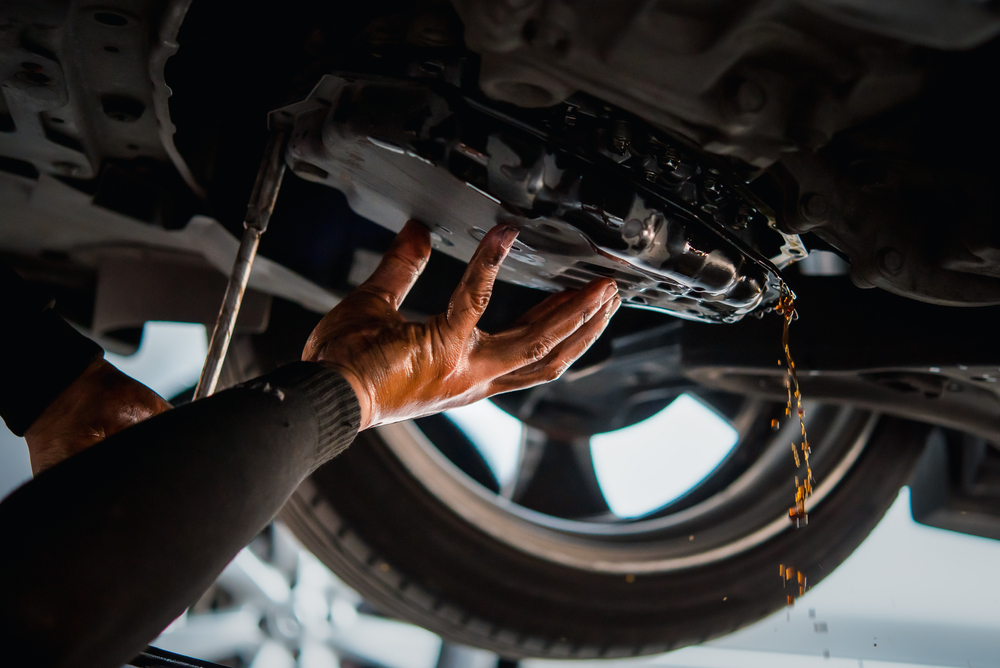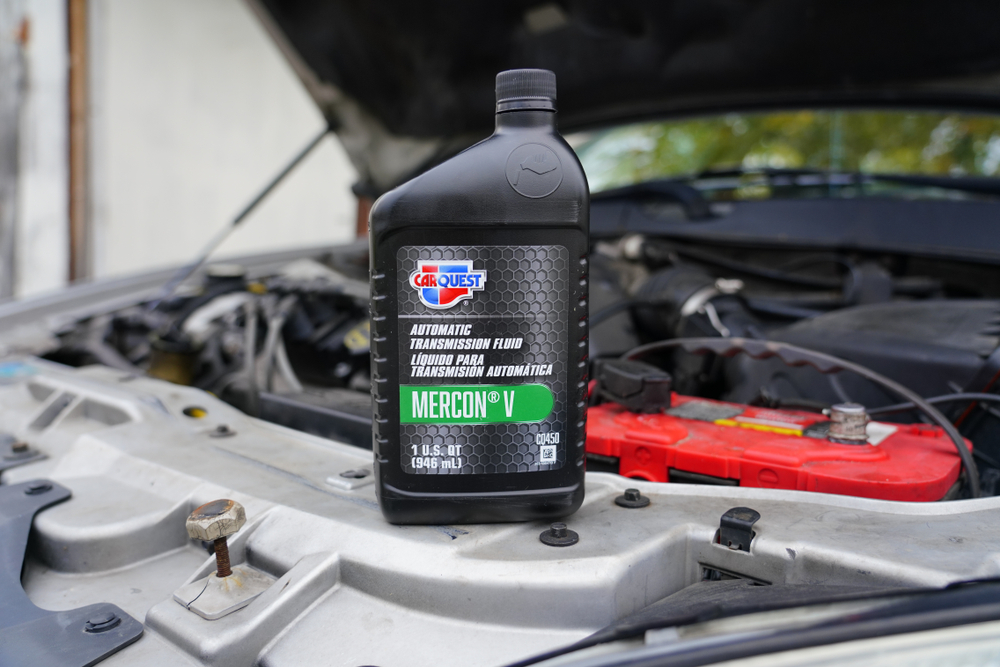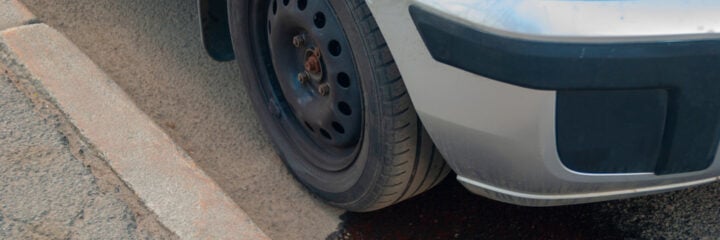Transmission leaks can resemble some kind of grizzly murder scene. There will be pools of red fluid, drips leading up your driveway, and people searching frantically with flashlights to find the source. If that sounds less like a nightmare and more like your current situation, you are in the right spot.
In this article, we’re going to look at the top 5 causes of transmission leaks and tell you how to fix them. After, we’ll talk a little about ATF and the dangers of a transmission leak.
The 5 Most Common Places a Transmission Will Leak From
Automatic transmission fluid, ATF, is easy to identify. It looks like standard engine oil, except it’s red and usually a bit thicker. The ATF belongs in the transmission, so if it’s on your garage floor or dripping off the bottom of your car, then you have a leak.
Manual transmission leaks are a bit more difficult to diagnose because manual transmissions don’t use special fluid. They just use standard oil. This list of common leaks still applies; it may simply take longer to notice because the color doesn’t stand out, and it can be difficult to check the oil levels of manual gearboxes.
Finding the Source
The source of the dripping is going to be your biggest clue as to what part you need to replace or repair. The problem is that finding that source can be a bit frustrating sometimes. A car’s underside is usually covered in dirt, grease, and other material that can make it very difficult to identify where a leak is coming from.
There are three steps you can take. You should do these steps in order because they rise in price and complexity. You may need to drive your vehicle or let the engine run to encourage the leak to leak to become more visible.
- Do your best to look for the leak with a flashlight. When you think you find the source, blast it with an engine cleaner like Gunk and wipe it down. Then see if you can catch the leak in the act.
- If you still can’t find the leak or suspect multiple areas may be leaking, try to coat the parts in talcum powder or flour. It’s a little messy, but it will highlight the leak when the flour bunches up, and the leak creates trails.
- If you still can’t find the leak, it’s time to break out the big guns. UV oil dye is a substance that fluoresces under UV. You dump the dye into the transmission fluid, run the car, then use a UV light to find the leak. It will look bright green and stand out sharply against any backdrop.
Keeping these methods in mind, we’re going to take you through some common areas where leaks occur and explain why.
1. Seals
Leaks from old or broken seals are unfortunately common. It’s unfortunate because they are probably the most labor-intensive to fix items on this list. There are a lot of seals on the transmission. The various sensors all have o-rings that seal them against the case, but the main seals are around the input shaft and the output shaft.
If the output shaft seal is leaking, you will find the leak at the back of the transmission. Usually, there will be fluid on the driveshaft. Front seals can be much harder to find because the transmission is bolted directly to the engine. Cars with differentials and/or transaxles can make it even more difficult to diagnose.
Fixing a Sensor Leak
It’s usually fairly easy to pull out a sensor or other small part and replace the o-ring or gasket. In fact, it’s common for the sensor itself to be inexpensive. If a sensor is leaking, it’s easy to replace the entire sensor in a short amount of time.
Fixing a Shaft Seal
You can try a transmission stop leak product. We have a write up about them here that includes a variety of different applications. If the seal is mostly intact or only has a very small crack, a stop leak additive may work fine.
However, you will likely need to remove the transmission in order to fix the leak. That’s a very involved process that requires a lot of space and some specialized tools. If you have those tools and knowledge, you don’t need us to tell you what to do. Go for it. If not, you should probably take your car to a transmission shop.
Transmission Shops
You can expect to spend around $1,000 on a basic transmission service that includes replacing the gaskets. A better option for most people is a complete transmission rebuild, which costs between $1,500 and $3,000 depending on how difficult it is to remove your transmission.
That’s a big investment, and some cars are not even worth that amount of money. If you are on a tight budget, or if you don’t want to pay to fix the issue, try a stop leak additive and make sure to keep the fluid topped off. Unless you get very low on oil, there isn’t much danger to your vehicle. There is just a big danger to the cleanliness of your garage.
2. Cooler Lines
Some transmissions have hoses that transport the transmission fluid up to the radiator or a separate transmission cooler. These lines can crack over time and begin to leak. These leaks can be a bit difficult to find because the fluid will travel along the line and drip at a low point rather than at the crack location.
The actual connection points usually don’t break. They are steel barbs or AN fittings and rarely have issues. The gaskets and internal seals can fail, but the most likely culprit is the area where the hose connects to the fittings. The solution is the same, no matter where the leak is.
Replacing the Line
The solution for a leaking line is very simple. You simply replace the line. The most difficult part is usually finding the right hose. Removing the old one and taking it into a parts store is usually the best way to go about it. Even different trims on the same make and model of car can have different transmission parts.
Universal lines are inexpensive, usually only costing $20 or so. Some factory replacement lines can cost as much as $100, although most are cheaper.
A mechanic can replace the line in less than an hour, so you can expect to spend between $75-150 on labor. If you budget $250 to have a mechanic do the work, you should be fine.
3. The Pan

The bottom of the transmission is a removable piece of sheet metal called the pan. There is a big gasket between the pan and the case of the transmission, and it is prone to leaking when it gets old.
The pan can also warp or become damaged and create gaps between the pan and the case. Since transmissions are underneath the car, they are prone to getting damaged during normal operation.
Stop Leak Additives
Just like with the seals, a stop-leak additive is sometimes a good solution for minor leaks. We have a write up about them here.
Replacing the Damaged Part
Transmission pan gaskets are inexpensive. The hardest part about replacing them is that you need to be able to lift your vehicle, and you need to be able to remove the fluid before you start. It can be very messy if you try to drop the pan without completely emptying out the fluid. The good news is we have an entire guide on oil extractors, so you are ready to go.
Otherwise, anyplace that can do oil changes can usually replace transmission fluid and, therefore, can replace the gasket. Expect to pay $100-200 for the procedure.
4. Drain Plug
The drain plug on a transmission usually won’t leak unless it was installed incorrectly. That does happen from time to time, and it’s worth checking if you have recently had work done on your car.
Unfortunately, there really isn’t a solution for this. You can try tightening the plug down, and if that solves the problem, great. But it’s more likely that the bolt is cross-threaded in, and the case is damaged. Since a new case is the same as a new transmission, it’s probably just easier to throw some newspaper under the car and live with a minor leak.
5. Physical Damage
The final issue you may encounter is the most expensive issue you can face. The only upside is that it’s a very rare problem. The transmission case or one of the shafts can be badly damaged. Cracks or holes in the case will leak fluid, and bent shafts will never fully seal against a gasket. Usually, these problems occur after an accident, so there’s little chance for them to go unnoticed.
If your transmission is badly damaged, then you need a new transmission. You might be able to weld a crack shut or patch a hole, but the time and labor it requires to do that will probably exceed the value of a new transmission.
Transmission Options
If you need to replace your transmission, you have three main options. A new transmission from the factory is the most expensive option. Transmissions are $2000+ new. A 2010 Honda Civic’s transmission is around $2,600.
A rebuilt transmission is a better option for most people. They can cost less than half a new transmission, and they will last just as long if they are rebuilt properly. The same 2010 Civic transmission is only $1700.
Finally, a used transmission can get you back on the road for as little money as possible. However, it is a risk. You don’t know how much life the used transmission still has in it. A used transmission from a junkyard can cost as little as $400, so it might be worth the risk.
Shop Rates
Once you have the replacement transmission, you will need to remove the old one and install it. If you have the means to do that, then you don’t need us to give you a guide. Grab your favorite circlip remover and get to work.
Otherwise, you’ll be paying a shop. You can expect to pay a transmission shop about $500 plus the cost of the transmission you choose. Don’t be afraid to go to a small shop and talk to the mechanic. Especially if you are on a tight budget. Mechanics are people, and they may be able to come up with a different solution that will save you a lot of money. Just be sure to bring them donuts after they do that.
ATF

Automatic transmission fluid is simply a kind of oil that is specially formulated for automatic transmissions. It is usually colored red to make it appear different from engine oil, although some specialty fluids can be green or blue.
ATF is usually considered a lifetime fluid. Unlike engine oil that burns and wears out over time, transmission fluid should last 100k miles without needing to be replaced. The transmission doesn’t heat up nearly as much as the engine, and the likelihood of it becoming contaminated is much lower.
Is It Dangerous?
You shouldn’t eat it if that’s what you mean by dangerous. However, the worst thing that a puddle of ATF will do is stain your concrete. Donut Media has a great video comparing different oil stain removal techniques.
Can You Still Drive With a Leak?
Is it dangerous to drive with a transmission leak? Only if the fluid level gets very low. Usually, you will encounter all sorts of warnings before that happens, though. Hard shifts, warning lights, and stuttering are all signs your ATF is low.
The bigger danger is actually contamination. A leak can not only let fluid out; it can let debris in. If enough particles get into the transmission, they can clump together and clog important channels or cause improper meshings. It’s a very rare problem, but the risk does exist, and it’s a good reason to fix the leak if you have the means.
Stop the Mess
No one wants unsightly fluid stains on their driveway. No one wants to have to spend a day cleaning concrete. If your transmission is leaking, though, you will have to choose one of those options. Use this guide to stop the leak, and stop stressing about drips.


